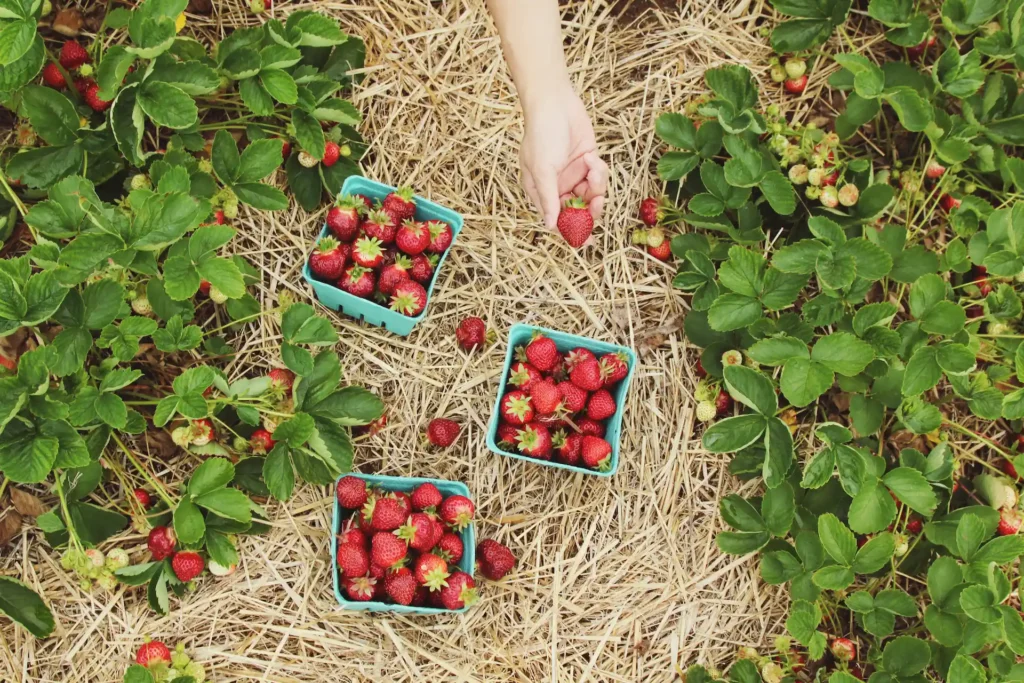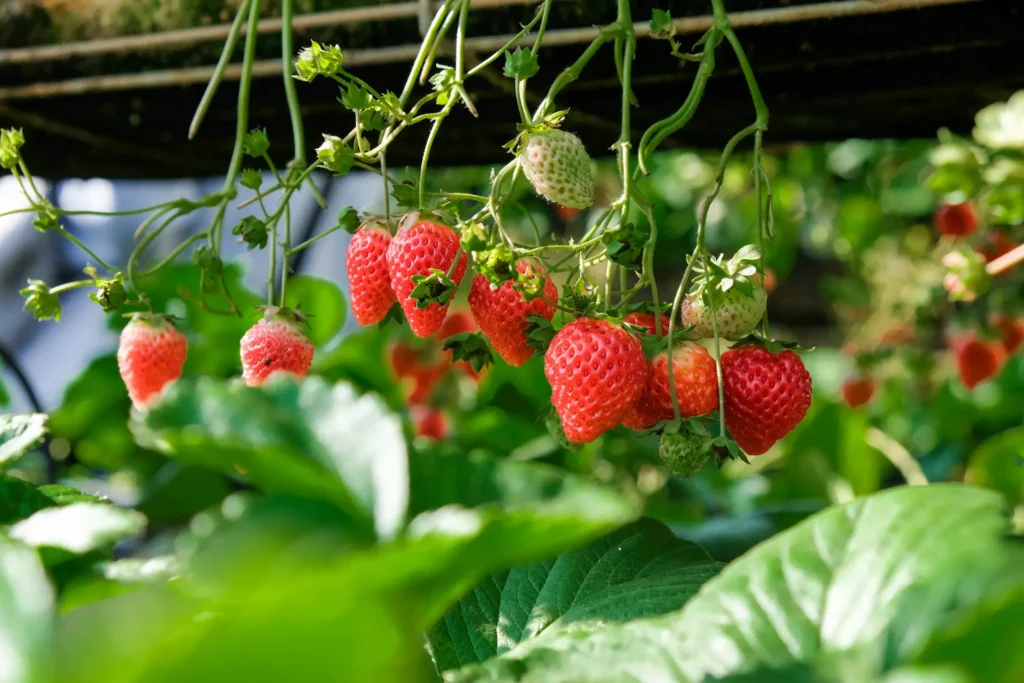Abundant strawberries in summer? Start with these spring tips in March!
Strawberries are a great snack. I remember how my grandmother used to prepare them in the summer with cream and sugar 🙂 Something wonderful! However, to enjoy them in your garden, you need to do a few simple things. Let me explain how to care for strawberries in spring so that they bloom as long as possible.
First clear the bed of all debris, including last year’s leaves and old mulch. Then apply a nitrogen-rich fertilizer. This will encourage the growth of the plants. Remember to protect your bushes from pests and fungi by prepping your spray with the right ingredients. Lastly, weed the strawberries frequently and give them continuous hydration, and they will repay you with tasty, nutritious fruits.
Optimizing Strawberry Growth Through Effective Spring Weeding Practices
Think weeds are just a little unsightly? In your strawberry patch, they’re the enemy! Weeds are like selfish roommates for strawberries. They steal the water, sunlight, and nutrients that your berries require to grow large and luscious. Furthermore, weeds can crowd your plants, making them stuffy and more susceptible to disease. By removing the weeds, you give your strawberries the space and nutrients they require to grow!
When to Get Your Hands Dirty:
Don’t rush it! Wait until those last frosty nights are over and your strawberry plants are looking perky and green. That’s usually sometime in late March or early April, depending on your climate. Weeding too early could stress out those young plants.
Your Weed-Busting Toolkit:
No fancy gadgets are needed here:
- Trowel: Your trusty sidekick for loosening up soil and gently prying out weeds.
- Garden Fork: Handy for tough soil or weeds with super stubborn roots.
- Gloves: No need for scratched-up hands. Those weeds can be surprisingly prickly!
Know Your Foes:
Keep an eye out for usual suspects like crabgrass, chickweed, and dandelions. These freeloaders will steal everything your strawberries need to thrive.
Weed Removal 101:
- The Classic Yank: Works like a charm in established patches. Grab the weed close to the ground, give a firm tug, and get that root outta there!
- Strategic Digging: For those extra stubborn weeds, loosen the soil around them with your trowel. Be a strawberry plant ninja – careful not to disturb the roots!
- The Chemical Option: If things are really out of control, there are herbicides made for strawberries. But remember, always follow the instructions and only use them after your plants are done flowering.
The Science Behind a Weed-Free Patch:
Don’t just take my word for it – research shows that one solid weeding session in spring makes a HUGE difference. Fewer weeds all season long and healthier strawberries? Yes, please!
Post-Weeding TLC:
- Thirsty Work: Your strawberries probably deserve a big drink after their battle for resources.
- Mulch = Weed Shield: Toss down some straw or woodchips to keep those new weeds at bay and the soil nice and moist.
Stay Vigilant:
Check on your patch every so often and nail any new weeds while they’re small. You’re basically giving your strawberries their own personal bodyguard!
Give Your Strawberries a Spring Boost! The What and How of Fertilizing
Think of strawberries as the fruit version of Olympic athletes – they need the right fuel to perform their best! Spring is when you get to be their personal nutritionist, giving them what they need for juicy berries all season. Let’s break down easy ways to feed those champs.
What Your Strawberries Crave?
Like us, strawberries need a balanced diet! Here’s the big three:
- Nitrogen (N): Think of it as the green leafy stuff, helping plants grow strong at the start of the season.
- Phosphorus (P): Super important for roots and flowers, which means more berries later on! Plus, it makes plants tough against pests and diseases.
- Potassium (K): This one’s the flavor booster! It also helps your plants handle the summer heat and stay healthy overall.
Supermarket vs Farmers Market: Which Fertilizer to Choose?
Head to the garden center and you’ll see bags with numbers like 5-10-10 or 10-20-20. That’s your N-P-K ratio. For spring, go with a higher number in the middle and end (for that juicy berry boost from phosphorus and potassium).
Want to go the natural route? Aged compost or fish stuff is good, but you might need to feed your plants more often.
Science Says: Turns out, studies show balanced fertilizers with extra potassium in spring mean bigger harvests! (Think plump, perfect berries by summer.)
How to Actually Feed Your Strawberries:
- Timing is Everything: Wait until winter’s totally gone and those leaves start popping up on your plants (that’s usually late March or early April). Too early, and your strawberries might forget about making berries!
- Spread it or Band it: You can sprinkle fertilizer evenly around your plants (keep it a few inches away so you don’t burn any roots) or make little fertilizer ‘lines’ down the side of the row.
- Don’t Forget the Drink: Water your strawberries well afterward! Helps those fertilizer bits work their magic.
Foliar and soil fertilization methods
| Feature | Foliar Fertilization | Soil Fertilization |
|---|---|---|
| Description | Fertilizer is dissolved in water and applied as a spray to the leaves of the plant. | Fertilizer granules are sprinkled around the base of the plant and gently mixed into the topsoil. |
| Absorption | Nutrients are absorbed directly through the leaves. | Nutrients are absorbed through the plant’s roots. |
| Speed of Action | Provides a quick boost of nutrients, often visible within days. | Takes longer to see results, as nutrients need to reach the roots. |
| Best Suited For | Correcting minor nutrient deficiencies and providing a supplemental source of nutrients. | Long-term feeding and providing the main source of nutrients. |
| Considerations | Risk of leaf burn if the solution is too concentrated or applied during hot weather. | Over-fertilization can be an issue, potentially harming plants and the environment. |
The Pro Tip:
Get your soil tested! It’s like a checkup for your garden, showing exactly what those strawberries might be missing so you can feed them right. Think of compost as a healthy snack – it makes your soil better over time too.
Berry Protection: Mastering Springtime Spraying for Healthy Strawberries

Spring is a double-edged sword for strawberries – warm days mean new growth, but also a wake-up call for those nasty bugs and diseases. A little know-how with the spray bottle early in the season can make all the difference between a bumper crop and disappointment. Let’s break it down so you can protect your berries like a pro.
Know Your Enemies: Bugs & Fungus 101
- Powdery Mildew: The sneaky white dust ruining your leaves and fruit? That’s this fungus ruining your harvest. Catch it early, or it spreads like wildfire.
- Botrytis (Gray Mold): Turns those perfect berries into fuzzy, gross messes. Cleanliness in your patch and some prevention are key!
- Verticillium Wilt: Starts underground, but it can completely kill your plants. This is why you choose strong varieties and never plant where strawberries had problems before.
- Aphids: Think of them as tiny, plant-sucking vampires – they weaken your plants and can spread other problems. Keep an eye out for these guys.
- Spider Mites: They’re super small, but those speckled leaves are a bad sign. Bad infestations can take down whole plants, so be vigilant.
- Spotted Wing Drosophila (SWD): These nasty fruit flies ruin berries from the inside out. This one’s tough, so keeping your patch clean and watching for signs is super important.
The Science Part: Studies actually show that spraying preventatively with the right fungicides in spring makes a HUGE difference for your strawberry crop! (Who doesn’t love more berries?)
Choosing Your Weapons: Smart Spraying for Success
- Fight Fungus: Think ahead when it comes to those powdery mildew and mold issues, especially if your strawberries had trouble last year.
- Go Organic Whenever You Can: Copper sprays and neem oil are good for many problems and less likely to hurt the good bugs.
- Backup Plan: Sometimes the bugs get out of hand and you need the stronger stuff. But remember, ONLY use those when you have to and always follow the instructions to the letter.
- Don’t Overdo It on Bug Sprays: A healthy patch has good bugs eating the bad ones! Only spray insecticides if the pest problem gets REALLY bad.
- “Targeted Attack” is Better: Stuff like soapy water and spinosad can control specific pests without wiping out the helpers in your strawberry patch.
- Instructions are Golden: Pesticides can be dangerous if you don’t use them exactly right, for you and your garden. Read those labels!
Spraying Like a Pro:
- No Wind: Keeps the spray going where you want it and keeps it off everything else.
- Cool is Best: Early morning or evening means your plants won’t get sunburned from the spray.
- Top and Bottom: Those bugs and diseases hide on the UNDERSIDE of those leaves, so be thorough.
- Test First: New product? Do a little test with a weak spray to make sure your strawberries can handle it.
Soil Drenches: Getting to the Root of the Problem
- Measure Twice: No sense in harming your strawberries or the soil with too much product. Follow the directions!
- Right at the Base: Avoid getting the spray on the strawberry leaves themselves.
- Water it in: Helps the good stuff (or bug killer) get down to the roots where it needs to be.
Gear Up!
Gloves, goggles… all that safety stuff is a MUST when spraying anything, even the organic stuff. Better safe than sorry!
Summary
OK. We went through all the details of spring care for strawberries. There is nothing left but to do our job. Remember that weed-free soil, with the right pH and lots of fertilizer will create a great environment for nice fresh strawberries. Oh, and remember the spraying. Make sure you choose an ecological option instead of a chemical for prevention.
Worth reading:
Strik, Bernadine Cornelia, et al. Growing strawberries in your home garden. Oregon State University, Extension Service, 2008.


